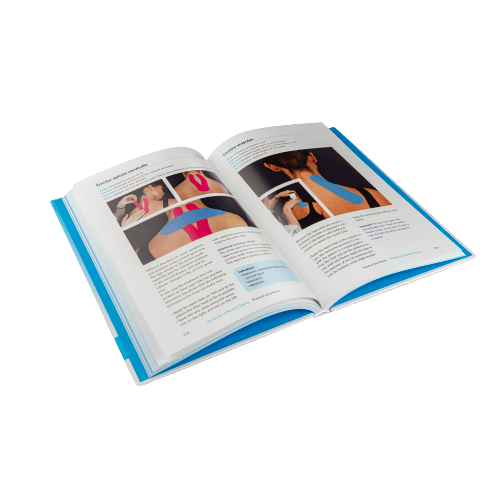How does a hamstring injury occur?
The hamstring is a collective name for a group of muscles located at the back of the thigh. The main function of the hamstring is to extend the hip and bend the knee joint. The hamstring also helps to rotate the knee. In many sportsmen and women, these muscles are often shortened; in explosive sports such as football and handball, the hamstring can easily be stretched or even torn.
The cause of this injury must also be sought in an imbalance of the thigh muscles (muscle length and strength) and instability of the trunk and pelvic muscles.
Hamstring strapping with CureTape® within the rehabilitation process
The recovery time from a hamstring injury often takes several weeks to three months, depending on the severity of the injury. Treatment with CureTape® supports the rehabilitation process and reduces the pain, restoring the function. This makes it easier to carry out muscle-strengthening and stabilising exercises of the trunk and pelvis. This tape application can also be used preventatively before sports or during competitions.
Get started with these items to tape your hamstring injury
-
CureTape® Sports Extra Sticky Kinesiology Tape
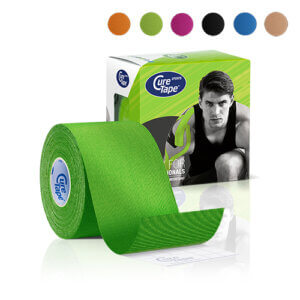 $21.95
In stockSelect options
$21.95
In stockSelect options -
MYCureTape® Sports Extra Sticky Kinesiology Tape Value Pack
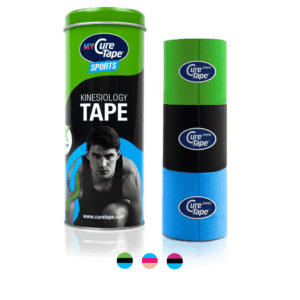 $28.95
In stockSelect options
$28.95
In stockSelect options -
Standard scissors
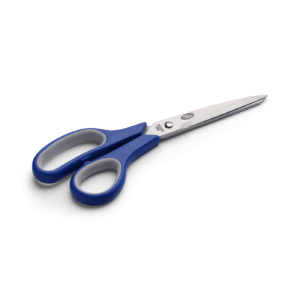 $14.95
In stockAdd to cart
$14.95
In stockAdd to cart -
CureTape® Giant Sports 31.5m Extra Sticky Kinesiology Tape Bulk Roll
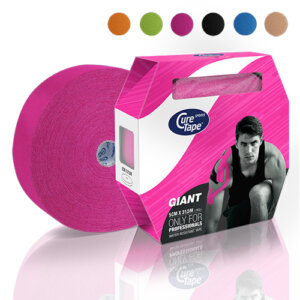 $116.95
In stockSelect options
$116.95
In stockSelect options
How to tape hamstring video
Instructions for professionals
- Green tape (CureTape Sports – lime):
- Measure the tape length with the hamstring in a stretched position by having the client stand or lie down.
- Place the end of the tape on the fibular head and the condylus laterlis / medialis tibae.
- Have the client extend the knee and bend the hips.
- Apply the CureTape with a 10% stretch to the sciatic tuberosity (just below the buttock).
- Rub CureTape well for better adhesion.
- Black tape (CureTape Sports – black):
- If there is a muscle tear, a cross can be applied over the affected area using the ligament technique as additional support.
Instructions for self taping (non-professionals)
- Green tape (CureTape Sports – lime):
- Measure the tape length while your leg is in a stretched position. You can do this by standing or lying down.
- Place the end of the tape on the outer side of your lower leg, just below your knee joint.
- Extend your knee and bend your hips.
- Apply the CureTape with a 10% stretch to the upper part of the back of your thigh, just below your buttock.
- Rub the tape well to ensure it sticks properly.
- Black tape (CureTape Sports – black):
- If you have a muscle tear, apply a cross over the painful area using the ligament technique for extra support.

Christina’s advice when taping your leg
When taping your leg, it’s crucial to choose a tape that provides strong adhesion and support. That’s why I recommend CureTape kinesiology tape. For regular use, CureTape Classic or Art is ideal. However, since feet can sweat and there’s lots of friction, I recommend to opt for the extra sticky CureTape Sports variant!

Learn how to tape
- The Ultimate Taping Guide: Focuses on self-taping for the 30 most common injuries where taping provides support.
- Kinesiology Taping Method Manual: Designed for (para medical) professionals, covering basic taping techniques and various pathologies.
- Decompressive Taping Techniques Manual: Specifically focuses on lymphatic taping methods for decompression.
What are you waiting for? Order a copy today!
THYSOL is the manufacturer of the kinesiology tape brand CureTape. As CureTape, we have been training and supplying professionals for 25 years. And consumers now know how to find us too! By manufacturing all our tapes in our own factory, we can guarantee the best quality!
Please note that the indicated tape applications and information on our website about the possibilities with kinesiology tape have not yet been scientifically proven. The statements and examples mentioned are based on long-term experiences of patients and trained therapists.Contraindications not to tape: pregnancy, open wounds, broken bones, unexplained complaints, allergies and skin diseases, use of medication such as blood thinners, thrombosis and fever. Always apply tape in consultation with a specialist.

